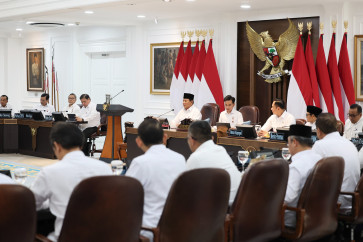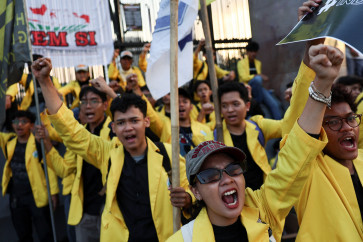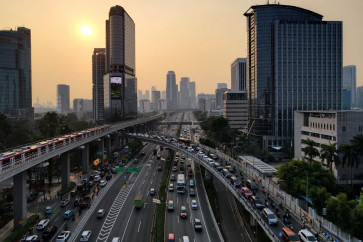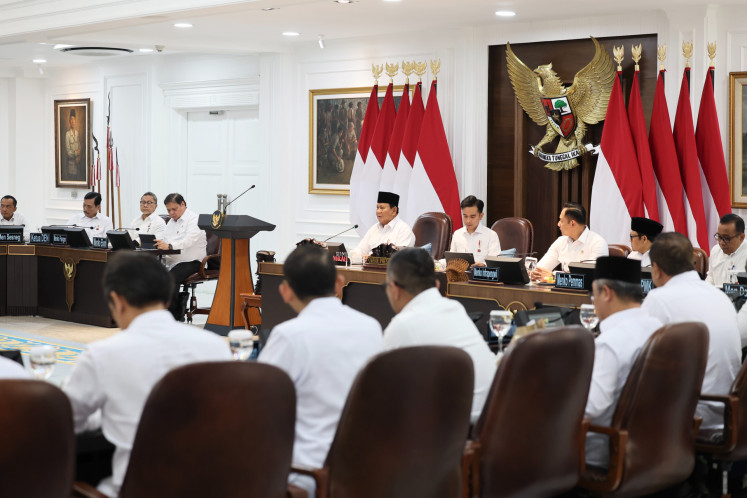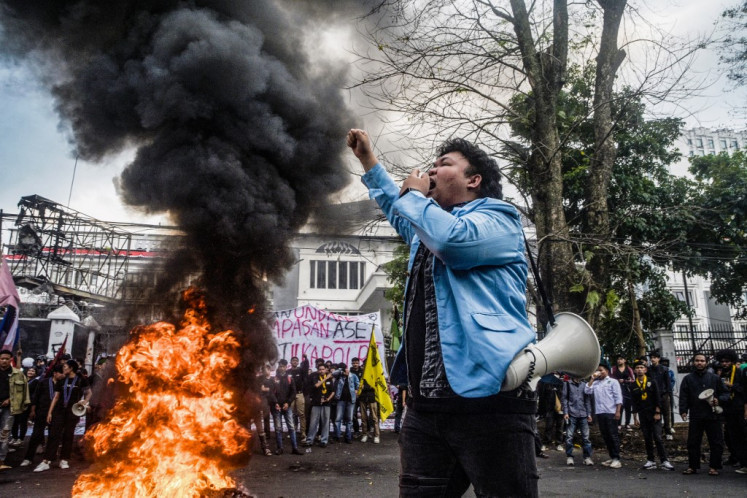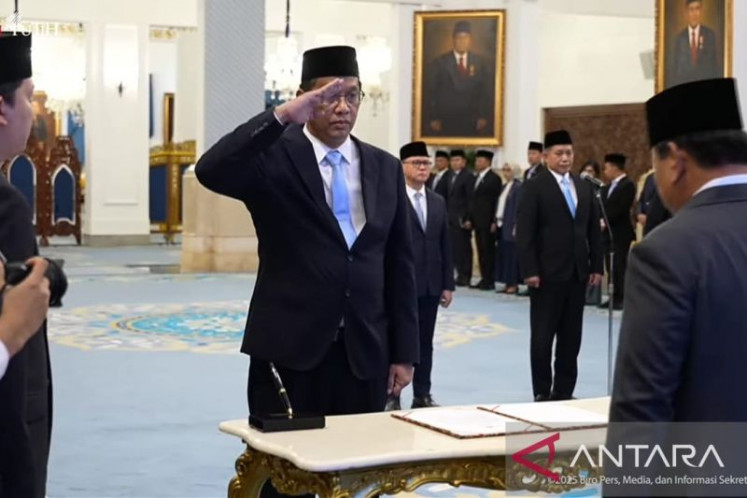Popular Reads
Top Results
Can't find what you're looking for?
View all search resultsPopular Reads
Top Results
Can't find what you're looking for?
View all search resultsRediscovering Indonesian fabric
Ivan Gunawan: (JP/Ricky Yudhistira)Indonesian fabrics do not begin and end with batik
Change text size
Gift Premium Articles
to Anyone
 Ivan Gunawan: (JP/Ricky Yudhistira)" border="0" height="500" width="282">Ivan Gunawan: (JP/Ricky Yudhistira)Indonesian fabrics do not begin and end with batik.
Ivan Gunawan: (JP/Ricky Yudhistira)" border="0" height="500" width="282">Ivan Gunawan: (JP/Ricky Yudhistira)Indonesian fabrics do not begin and end with batik. The countryâs talented designers continue to transform signature textiles and motifs into stunning creations â all with the idea of getting the worldâs attention.
Most designers apply one of two schemes to use local fabrics and motifs. Some are faithful in using the traditional textiles, turning them into modern-look outfits, while others create printed versions of traditional patterns and motifs using more modern fabrics.
Young designer Ivan Gunawan applied both methods to promote woven silk from Mandar, in Polewali, West Sulawesi. Mandar silk is known for its richness in color featuring symmetrical checkered patterns.
In a show entitled Malolo, or beauty in the local language, Ivan showcased an avant-garde collection in a playful atmosphere for an audience of urbane women.
To keep an Indonesian feel, Ivan mixed the dynamic cuts with the use of Mandar woven silk and also produced pieces featuring the motifs typically found on Mandar woven silk.
For the latter, the 31-year-old designer produced floral prints of tulips, peonies and orchids onto duchess, organdi, suede and lace. Ivan turned the design into classic mermaid silhouette in shocking pink and fuchsia colors.
âMandar woven fabric is a handmade. It takes a good period of time to produce a piece. To answer such a challenge, I chose to print the motifs in order to promote the piece to a wider market,â says Ivan, who also produces formal suits for men using Mandar woven fabrics and suede.
 Phillip Iswardono: (Courtesy of Indonesia Fashion Week)In the show, he also presented a beautiful panoramic view of Mandar, using large floral prints on duchess and organdi for his evening gown collection, which was enriched by pleats and pattern draping.
Phillip Iswardono: (Courtesy of Indonesia Fashion Week)In the show, he also presented a beautiful panoramic view of Mandar, using large floral prints on duchess and organdi for his evening gown collection, which was enriched by pleats and pattern draping. âOne of my aims in using Mandar woven silk is to support the presence of its weavers, who work in home industries.
By promoting it, I hope Mandar-based weavers can create better fabrics in much larger quantities.â
Meanwhile, Yogyakarta-based Phillip Iswardono displayed his unique interpretations in a ready-to-wear collection
using Central Javaâs striped lurik woven cloth.
In creating his latest collection, Phillip was inspired by lurik, which is commonly used by porters to carry peopleâs purchases in slings at traditional markets.
In Phillipâs hands, the lurik was transformed into modern, chic and yet casual looks for blazers, vests and pants for women, mixing traditional cloth with Javanese blue batik biron from Wukirsari in Bantul, Yogyakarta.
West Nusa Tenggara is among many productive regions in the country preserving and reenvisioning its legacy through fashion.
Muslim fashion designer Irna Mutiara was among several top designers interested in exploring the regionâs traditional textiles.
This year, Irna has been in charge of creating a collection for Reneo, a local brand looking to make the jump to the international market. After a trip to Lombok last year, Irna decided to learn about the fabric and create a simpler version for ready-to-wear industry.

I
span class="caption" style="width: 280px;">Ivan Gunawan: (JP/Ricky Yudhistira)Indonesian fabrics do not begin and end with batik.
The country's talented designers continue to transform signature textiles and motifs into stunning creations ' all with the idea of getting the world's attention.
Most designers apply one of two schemes to use local fabrics and motifs. Some are faithful in using the traditional textiles, turning them into modern-look outfits, while others create printed versions of traditional patterns and motifs using more modern fabrics.
Young designer Ivan Gunawan applied both methods to promote woven silk from Mandar, in Polewali, West Sulawesi. Mandar silk is known for its richness in color featuring symmetrical checkered patterns.
In a show entitled Malolo, or beauty in the local language, Ivan showcased an avant-garde collection in a playful atmosphere for an audience of urbane women.
To keep an Indonesian feel, Ivan mixed the dynamic cuts with the use of Mandar woven silk and also produced pieces featuring the motifs typically found on Mandar woven silk.
For the latter, the 31-year-old designer produced floral prints of tulips, peonies and orchids onto duchess, organdi, suede and lace. Ivan turned the design into classic mermaid silhouette in shocking pink and fuchsia colors.
'Mandar woven fabric is a handmade. It takes a good period of time to produce a piece. To answer such a challenge, I chose to print the motifs in order to promote the piece to a wider market,' says Ivan, who also produces formal suits for men using Mandar woven fabrics and suede.
Phillip Iswardono: (Courtesy of Indonesia Fashion Week)In the show, he also presented a beautiful panoramic view of Mandar, using large floral prints on duchess and organdi for his evening gown collection, which was enriched by pleats and pattern draping.
'One of my aims in using Mandar woven silk is to support the presence of its weavers, who work in home industries.
By promoting it, I hope Mandar-based weavers can create better fabrics in much larger quantities.'
Meanwhile, Yogyakarta-based Phillip Iswardono displayed his unique interpretations in a ready-to-wear collection
using Central Java's striped lurik woven cloth.
In creating his latest collection, Phillip was inspired by lurik, which is commonly used by porters to carry people's purchases in slings at traditional markets.
In Phillip's hands, the lurik was transformed into modern, chic and yet casual looks for blazers, vests and pants for women, mixing traditional cloth with Javanese blue batik biron from Wukirsari in Bantul, Yogyakarta.
West Nusa Tenggara is among many productive regions in the country preserving and reenvisioning its legacy through fashion.
Muslim fashion designer Irna Mutiara was among several top designers interested in exploring the region's traditional textiles.
This year, Irna has been in charge of creating a collection for Reneo, a local brand looking to make the jump to the international market. After a trip to Lombok last year, Irna decided to learn about the fabric and create a simpler version for ready-to-wear industry.
En Shirikie: (JP/Ricky Yudhistira)As a result, Irna produces around 15 looks in a layered style, applying a mix of thin and thick traditionally-made fabrics.
'I brought my own cotton to Lombok, and asked local weavers to the decrease density of cotton usage during the weaving process,' says Irna, showing off her see-through version of Lombok's woven textile, which allows her to use it as an outer or a vest for an edgy look.
With such a strategy, she adds, Lombok cloth becomes more wearable for up-to-date fashions and can be produced in a shorter time ' as compared to the usual two-month long in production.
'Hopefully, people will see the new face of the traditional cloth in modern fashion. If we can nail the middle to upper class or the Asian market, like Japa, for example, it would have great potential for Indonesia.'
Similar to West Nusa Tenggara, West Sumatra is also on the rise in promoting its fashion crafts.
Prominent West Sumatran designer En Shirikie said several artisans support weavers and craftsmen in all four of the province's regencies and its one municipality.
'I'm in charge of the development of fashion-related crafts in Payakumbuh, Mentawai, Padang Panjang and Agam,' she says.
En explained that Agam and Padang Panjang stood out for their unique motifs in krancang embroidery, while Payakumbuh had woven cloth and embroidery with terrific looks.
She said that West Sumatra is truly rich in embroidery, as the province has at least 30 needlework motifs and its own batik, in both handmade and print versions.
'Currently, I'm developing motifs from Mentawai embroidery. The design of those motifs will soon be applied to woven cloth with needlework as well as batik,' says En, adding that within five years she believes that Indonesia's woven cloth and embroidery will be as famous as batik nowadays.
The head of West Sumatra's industry and trade office, Afriadi Laudin, says that, the provincial crafts council has been working with local designers and a university in develop and promote local crafts.
'We've been also working with ITB [Bandung Institute of Technology] to find a formula in producing high quality cotton for woven cloth-based daily wear,' Afriadi, who is head of West Sumatra's crafts council, said.
He said the local designers play an important part in creating new looks using woven cloth and traditional motifs.
'The woven cloths and motifs are not solely owned by West Sumatra. Each region in the country has its own uniqueness. We just want to make fashion products using this fabric go national and global.'
Your Opinion Matters
Share your experiences, suggestions, and any issues you've encountered on The Jakarta Post. We're here to listen.
Thank You
Thank you for sharing your thoughts. We appreciate your feedback.
Share options
Quickly share this news with your network—keep everyone informed with just a single click!
Gift Premium Articles
to Anyone
Share the best of The Jakarta Post with friends, family, or colleagues. As a subscriber, you can gift 3 to 5 articles each month that anyone can read—no subscription needed!
Continue in the app
Get the best experience—faster access, exclusive features, and a seamless way to stay updated.

